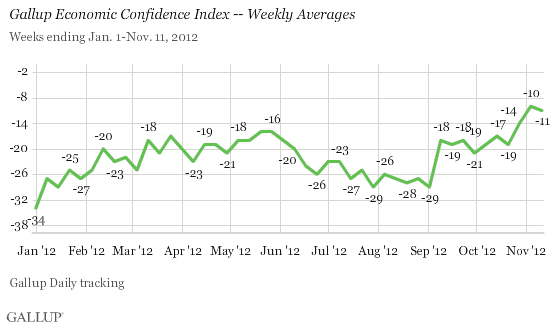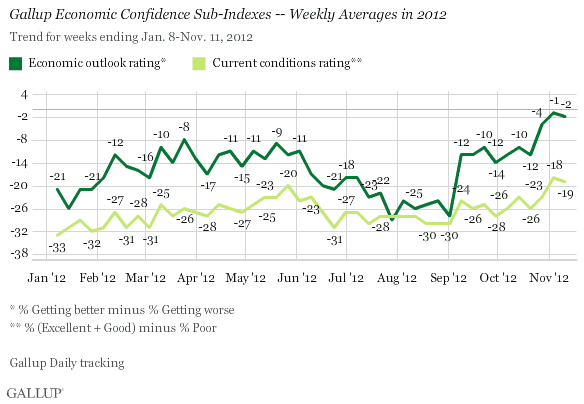WASHINGTON, D.C. -- Gallup's U.S. Economic Confidence Index was -11 for the week ending Nov. 11, little changed from -10 the week prior. Economic confidence has maintained its improved level during the first part of November -- with the most favorable readings of the year and since the economic downturn in 2008.

Although economic confidence was -11 for the week, the measure was a bit worse later in the week, ending at -14 for Nov. 9-11, compared with -7 for Nov. 6-8. Confidence may have receded as a result of the drop in the stock market after the Nov. 6 election, and the renewed focus on the pending "fiscal cliff" at the end of the year.
The slight decrease in economic confidence resulted from small changes in both components of the index -- one that assesses current economic conditions and the other that assesses the nation's economic outlook. The -2 economic outlook rating is down slightly from -1 the week before, but the scores are the most favorable evaluations so far this year. In fact, this is the closest the component has come to reaching positive territory since the economic downturn. Forty-seven percent of Americans say the economy is getting better, while 49% say it is getting worse.
Seventeen percent of Americans say the economy is excellent or good, while 36% say it is poor, resulting in a -19 current conditions rating, down slightly from -18 the week prior. The current-conditions readings in early November are also the most positive they have been since the economic downturn.

Economic confidence was essentially unchanged among Democrats (at +36) and Republicans (-58) last week, despite the re-election of President Barack Obama on Nov. 6. Independents, on the other hand, had a seven-percentage-point decline to -17, down from -10 the week before. Both the economic outlook and current conditions scores declined among independents. The lack of change among Democrats and Republicans may not be surprising, given that the incumbent was re-elected and both parties may expect the same economic policies and conditions to persist. On the other hand, had Romney secured the presidency, attitudes about the future of the economy might have changed.

Bottom Line
Economic confidence continues to improve but still needs to make gains to reach positive territory. The election results did little to change the immediate post-election evaluations of the economy. Now that the election is over, it will be interesting to see if the sharp political divide continues despite any changes in the economy.
Events besides politics will play an important role in economic confidence as the year comes to a close. Fears of America's looming fiscal cliff and Europe's continued struggles to recover have slowed trading in recent weeks, which may dampen the recent improvement in economic confidence. On the other hand, holiday sales that meet or exceed expectations and continued improvements in the unemployment rate could bolster opinions of the economy, with continued gains seen into 2013.
Gallup.com reports results from these indexes in daily, weekly, and monthly averages and in Gallup.com stories. Complete trend data are always available to view and export in the following charts:
Daily: Employment, Economic Confidence, Job Creation, Consumer Spending
Weekly: Employment, Economic Confidence, Job Creation, Consumer Spending
Read more about Gallup's economic measures.
View our economic release schedule.
Survey Methods
Results are based on telephone interviews conducted as part of Gallup Daily tracking Nov. 5-11, 2012, with a random sample of 3,470 adults, aged 18 and older, living in all 50 U.S. states and the District of Columbia.
For results based on the total sample of national adults, one can say with 95% confidence that the maximum margin of sampling error is ±1 percentage point.
Interviews are conducted with respondents on landline telephones and cellular phones, with interviews conducted in Spanish for respondents who are primarily Spanish-speaking. Each sample includes a minimum quota of 400 cellphone respondents and 600 landline respondents per 1,000 national adults, with additional minimum quotas among landline respondents by region. Landline telephone numbers are chosen at random among listed telephone numbers. Cellphone numbers are selected using random-digit-dial methods. Landline respondents are chosen at random within each household on the basis of which member had the most recent birthday.
Samples are weighted by gender, age, race, Hispanic ethnicity, education, region, adults in the household, and phone status (cellphone only/landline only/both, cellphone mostly, and having an unlisted landline number). Demographic weighting targets are based on the March 2011 Current Population Survey figures for the aged 18 and older non-institutionalized population living in U.S. telephone households. All reported margins of sampling error include the computed design effects for weighting and sample design.
In addition to sampling error, question wording and practical difficulties in conducting surveys can introduce error or bias into the findings of public opinion polls.
For more details on Gallup's polling methodology, visit www.gallup.com.
